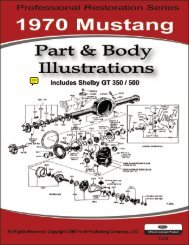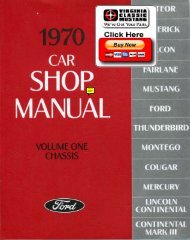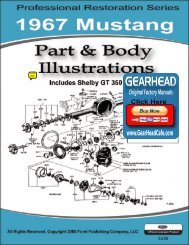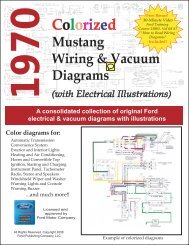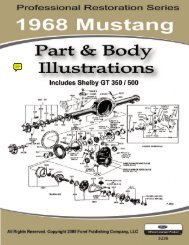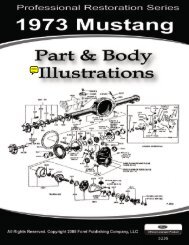DEMO - 1965 Ford Truck Shop Manual - ForelPublishing.com
DEMO - 1965 Ford Truck Shop Manual - ForelPublishing.com
DEMO - 1965 Ford Truck Shop Manual - ForelPublishing.com
You also want an ePaper? Increase the reach of your titles
YUMPU automatically turns print PDFs into web optimized ePapers that Google loves.
PART 2-6 - AIR SUPPLY SYSTEM 2-73<br />
INSTALLATION<br />
Fuel Pump and Air Compressor—<br />
F-, H-, T- and N-Series <strong>Truck</strong>s<br />
1. Clean the gasket material from<br />
the <strong>com</strong>pressor, gear case, and accessory<br />
drive rear support plate.<br />
2. Position the air <strong>com</strong>pressor with<br />
a new gasket to the front side of the<br />
gear case so that the timing marks<br />
on the air <strong>com</strong>pressor drive gear are<br />
aligned with the marks on the camshaft<br />
gear (Fig. 12). Be sure that the<br />
gears mesh properly.<br />
3. Position the accessory drive<br />
rear support plate with a new gasket<br />
to the rear side of the gear case, then<br />
secure the support plate and air <strong>com</strong>pressor<br />
to the gear case with the<br />
lockwashers and retaining bolts.<br />
4. On F-, T- and N-Series trucks,<br />
clean the gasket material from the<br />
water crossover pipe and the rear of<br />
the cylinder heads. Position the crossover<br />
pipe to the cylinder heads with<br />
new gaskets and install the retaining<br />
bolts.<br />
5. Connect the two water lines<br />
(<strong>com</strong>pressor - to - cylinder block and<br />
<strong>com</strong>pressor-to-water crossover connection).<br />
6. Connect the main air outlet<br />
line to the <strong>com</strong>pressor.<br />
7. Connect to the governor all air<br />
lines that were disconnected during<br />
removal.<br />
8. On F- and T-Series trucks, connect<br />
the <strong>com</strong>pressor air intake hose<br />
and secure with two clamps.<br />
9. Secure any water or air line-tosheet<br />
metal clamps that were disconnected<br />
during removal.<br />
10. On F-, T- and N-Series trucks,<br />
install the floor pan cover at the gear<br />
shift lever.<br />
11. Clean the gasket material from<br />
the pump mounting surfaces, position<br />
a new gasket, install the fuel pump to<br />
the front side of the <strong>com</strong>pressor, and<br />
connect the throttle linkage and lines<br />
as described in Group 10.<br />
12. On F- and T-Series trucks, fill<br />
the cooling system, charge the reservoirs<br />
and check for leaks.<br />
On H- and N-Series trucks, first install<br />
the air intake system <strong>com</strong>ponents<br />
as outlined in the following procedure.<br />
Air Intake Lines-H- and N-<br />
Series <strong>Truck</strong>s Only<br />
1. Install the right air cross-over<br />
manifold to the engine intake manifold,<br />
connect the <strong>com</strong>pressor air intake<br />
hose to the cross-over manifold<br />
and to the <strong>com</strong>pressor, and<br />
position the connection hose on the<br />
right and left cross-over manifolds<br />
(Fig. 11).<br />
2. Install the air cross-over manifold<br />
retaining bolts, and tighten the<br />
two clamps on the <strong>com</strong>pressor air intake<br />
hose.<br />
3. Tighten the clamps on the connection<br />
hose.<br />
4. Connect the air intake duct to<br />
the air cross-over manifold and<br />
tighten the clamp.<br />
5. Fill the cooling system, charge<br />
the reservoirs, and check for leaks.<br />
GOVERNOR<br />
REMOVAL<br />
The governor is mounted to the<br />
<strong>com</strong>pressor with two retaining bolts.<br />
Mating ports in the governor and<br />
<strong>com</strong>pressor bodies connect governor<br />
pressure to the unloading pistons in<br />
the <strong>com</strong>pressor. Reservoir pressure<br />
is connected to the governor through<br />
a hose or tube.<br />
1. Exhaust the air brake system.<br />
2. On vertically-mounted units,<br />
disconnect the governor hose (end<br />
opposite governor) from the fitting<br />
in the reservoir pressure line. On<br />
side-mounted units, disconnect the<br />
pressure line at the governor.<br />
3. Remove the two mounting<br />
bolts, then remove the governor.<br />
INSTALLATION<br />
1. On vertically-mounted units,<br />
transfer the hose to the replacement<br />
governor.<br />
2. Install the governor and gasket<br />
and the two retaining bolts to the<br />
<strong>com</strong>pressor. Apply sealer.<br />
3. On vertically-mounted units,<br />
connect the hose to the fitting on the<br />
reservoir pressure line. On sidemounted<br />
units, connect the pressure<br />
line to the governor.<br />
4. Test the governor as outlined<br />
in Part 2-1.<br />
PRESSURE INDICATOR VALVE<br />
The low pressure indicator valve is<br />
mounted at the passenger side of the<br />
TO WINDSHIELD<br />
TO TRACTOR<br />
WIPER BUZZER PROTECTION VALVE<br />
CONTROL SWITCH EMERGENCY LINE<br />
TO DASH<br />
GAUGE<br />
TO HAND<br />
CONTROL<br />
VALVE<br />
TO MANUAL<br />
EMERGENCY VALVE<br />
H1184-A<br />
FIG. 13—Pressure Indicator<br />
Valve<br />
dash panel (Fig. 13), and taps into a<br />
reservoir pressure line on the engine<br />
side of the panel.<br />
REMOVAL<br />
1. Turn the ignition switch to the<br />
"off" position and exhaust the air<br />
from the brake system.<br />
2. Disconnect the wire at the<br />
buzzer switch.<br />
3. Disconnect the air line to the<br />
dash gauge and the line to the windshield<br />
wiper control. On some full<br />
air systems, also disconnect the lines<br />
to the tractor protection valve, to the<br />
manual emergency valve, and to the<br />
hand control valve (Fig. 13).<br />
4. Unscrew the pressure indicator<br />
fitting at the engine side of the dash<br />
panel, and remove the assembly from<br />
the passenger side.<br />
INSTALLATION<br />
1. Mount the replacement unit to<br />
the passenger side of the dash panel<br />
and secure it to the panel by screwing<br />
on the pressure indicator fitting<br />
at the engine side.<br />
2. Connect the wire to the buzzer<br />
switch, and connect the dash gauge<br />
and windshield wiper control lines.<br />
On some full air systems, connect the<br />
other lines as shown in Fig. 13.<br />
MAJOR REPAIR OPERATIONS<br />
Major repair operations are not<br />
applicable to this section. If the <strong>com</strong>pressor,<br />
reservoirs, governor, low<br />
pressure indicator, and/or dash<br />
gauge is defective, the <strong>com</strong>ponent<br />
must be replaced.




